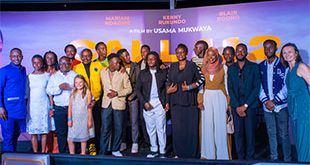
KAMPALA, UGANDA | THE INDEPENDENT | Visually impaired students of St. Mary Goretti Secondary School are missing out on the promise of digital inclusivity due lack of essential technologies.
Located in Ngetta- Lira City East Division, St. Mary Goretti is the only secondary school in Lango dedicated to visually impaired learners. It has a total of 45 learners in senior one and two; 10 who are completely blind and 12 with low or partial vision.
The school was established by the Itinga Charity Education Foundation (ICEF), a non-governmental organization, and built on land donated by the Lira Catholic Diocese.
However, lack of essential adaptive technologies such as computers, talking calculators, Braille tablets, audio learning aids, and other critical tools tailored to meet the needs of learners does not only make learning difficult but also further marginalize them in a digital-first world.
Luke Etuk, the head teacher of the school explains that without these adaptive devices, routine tasks like reading or and solving math problems, is difficult for visually impaired children. Adding that the school do not have enough resources to procure such devices.
“But above all, there are other things like technology has come in. We need things like talking calculator, where the child can navigate mathematics on the calculator. The calculators we have on the market here does not suit these learners because it doesn’t communicate directly to them and this is a challenge.”
Etuk notes that as demand for digital literacy continues to grow, the inability to access adaptive technologies poses insoluble obstacles for these learners, limiting their potential to contribute meaningfully to society in the future.
Etuk highlighted how the limited number of Orbit readers at the school forces them to rely on traditional Braille methods, which involve high transportation costs to purchase materials in Kampala.
“Bridging this gap requires a collective effort from the government, nonprofit organizations, and private sector entities to ensure that no child is excluded from the transformative power of technology,” he emphasized.
In an effort to address these challenges, MTN Uganda, through its MTN Change Maker initiative, donated three desktop computers equipped with Braille JAWS software worth valued at 20 million shillings to the school. The other items donated include 40 sitting desks, creating additional 80 learning spaces for the students.
Brian Kagwisagye, MTN’s Regional Business Manager for Northern Uganda, implored the students to use the computers to tap into available opportunities in the education sector.
“Education remains one of the most powerful tools for empowerment, yet for many learners with disabilities, access remains a challenge. Through technology and infrastructure support, we hope to enable these students to pursue their ambitions unhindered,” he said.
Kagwisagye noted that this intervention, under the MTN Foundation, is part of MTN Uganda’s broader Ambition 2025 strategy, which aims to foster digital and financial inclusion and promote education for all across Uganda.
“This initiative aligns with the United Nations Sustainable Development Goals (SDGs), particularly Goal 4 on quality education and Goal 10 on reduced inequalities,” he emphasized.
Eluk, the school’s head teacher welcomed the donation saying “We do not take this gesture for granted; it has far-reaching educational benefits and associated fruits.”
“This assistance will go a long way in boosting, enhancing, and facilitating the teaching and learning of Information and Communication Technology (ICT). The new lower secondary curriculum advocates for computer proficiency and ICT integration in the learning process and this will enable the children to conduct research and gain in-depth knowledge of learning concepts,” he added.
Meanwhile Mathew Omara, the chairperson of the Lira City Union of Persons with Disabilities (LUDIPU), explained how such donations help retain the few students who join in secondary schools. He urged the government, through the Ministry of Education, to code the school.
A 2009 World Health Organization report indicate that globally, an estimated 40 to 45 million people are totally blind, 135 million have low vision and 314 million have some kind of visual impairment. In most industrialized countries, approximately 0.4% of the population is blind while in developing countries it rises to 1.0%.
****
URN
 The Independent Uganda: You get the Truth we Pay the Price
The Independent Uganda: You get the Truth we Pay the Price



